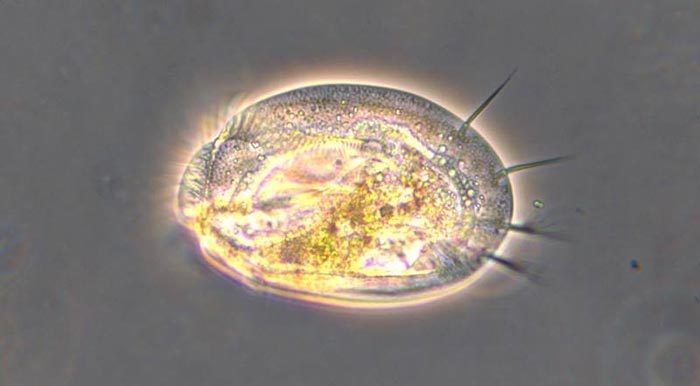Microbes offer a glimpse into the future of climate change

Single-celled protists like this Euplotes sp. are found in freshwater habitats worldwide and contribute to climate change by releasing carbon dioxide through respiration, a process that is changing with a warming climate.
Image courtesy of Daniel J. Wieczynski
Scientists identify key features in microbes that predict how warming affects carbon dioxide emissions.
The Science
Microbes play an important role in climate because they release carbon dioxide into the atmosphere when they eat. Bacteria and their main predators, protists, account for more than 40 times the biomass of all animals on Earth. As a result, they have a huge effect on carbon dioxide emissions. However, predicting the size of that effect and how global warming will affect microbial carbon dioxide emissions is challenging. Researchers showed that measuring certain features of microbes—like size and shape—allows them to reliably predict how respiration in those microbes will change as temperatures rise. The findings create a new source of information on the pace of climate change.
The Impact
Understanding how warming will affect microbial respiration is difficult because microbial communities are incredibly diverse and complex. This study shows that the complexities of how microbes respond to warming can be disentangled by studying the microbes’ traits. These findings suggest that scientists can make reliable, general predictions about this important component of the global carbon cycle and its effects on climate. In addition, the findings may be useful for making predictions about other systems that also shape the Earth’s climate.
Summary
Predicting how ecosystems will respond to climate change is one of the most pressing issues in ecology. Researchers have argued that understanding complex ecosystem responses requires a framework that mechanistically links organisms to their environment, then scales these interactions up to the population, community, and ecosystem levels. Functional traits are measurable characteristics of organisms that make this linkage possible by controlling variation in individual growth, survival, and reproduction across environments. This study measured key traits in protists—cell size, shape, and contents—and found that species with different trait values respond differently to changes in temperature, in terms of population growth rate. The scientists also found that these trait-based differences in population growth create differences in competitive ability, controlling protist community structure and ecosystem-level features like biodiversity and total respiration rate across temperatures in predictable ways. Understanding complex ecosystem responses to global climate change is especially difficult because ecosystems involve myriad interactions across levels of organization and a diversity of species, each with unique environmental responses. In this study, traits provide a way to reduce this complexity by exposing systematic variation in environmental responses across species and levels of organization. Protists and their bacterial prey play a major role in carbon flux by breaking down organically stored carbon and releasing it into the atmosphere through respiration.
These findings are thus crucial for understanding how climate change will alter this essential microbial component of the global carbon cycle. But these results also imply that such a trait-based approach may extend to other systems and could be incorporated into earth system models, informing ecosystem responses to climate change in general. Overall, this provides a glimmer of hope for disentangling the complexity of ecosystems and predicting the causes and consequences of future climate change.
Funding
This work was supported by the Department of Energy Office of Science, Office of Biological and Environmental Research.
Journal: Proceedings of the National Academy of Sciences
DOI: 10.1073/pnas.2104863118
Method of Research: Experimental study
Subject of Research: Not applicable
Article Title: Linking species traits and demography to explain complex temperature responses across levels of organization
Article Publication Date: 19-Oct-2021
Media Contact
Michael Church
DOE/US Department of Energy
michael.church@science.doe.gov
Office: 2028416299
All latest news from the category: Ecology, The Environment and Conservation
This complex theme deals primarily with interactions between organisms and the environmental factors that impact them, but to a greater extent between individual inanimate environmental factors.
innovations-report offers informative reports and articles on topics such as climate protection, landscape conservation, ecological systems, wildlife and nature parks and ecosystem efficiency and balance.
Newest articles

Innovative 3D printed scaffolds offer new hope for bone healing
Researchers at the Institute for Bioengineering of Catalonia have developed novel 3D printed PLA-CaP scaffolds that promote blood vessel formation, ensuring better healing and regeneration of bone tissue. Bone is…

The surprising role of gut infection in Alzheimer’s disease
ASU- and Banner Alzheimer’s Institute-led study implicates link between a common virus and the disease, which travels from the gut to the brain and may be a target for antiviral…

Molecular gardening: New enzymes discovered for protein modification pruning
How deubiquitinases USP53 and USP54 cleave long polyubiquitin chains and how the former is linked to liver disease in children. Deubiquitinases (DUBs) are enzymes used by cells to trim protein…



